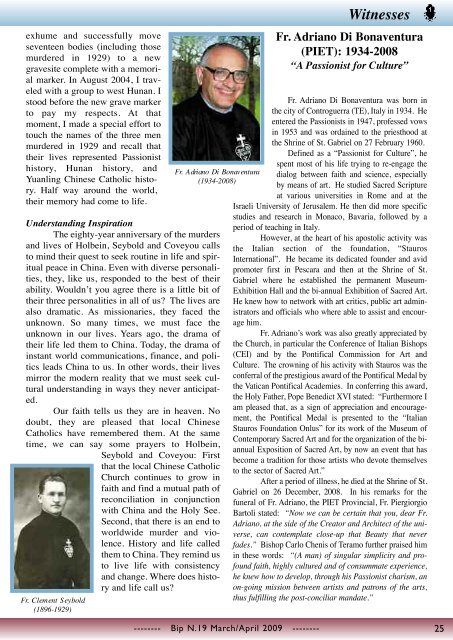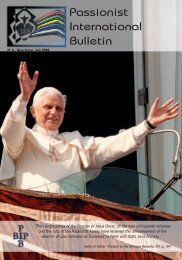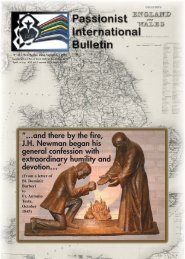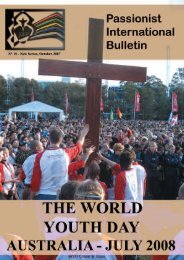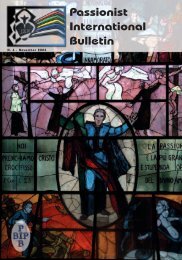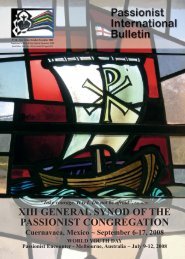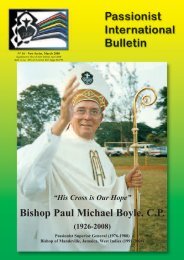The Curia Informs - Passio Christi
The Curia Informs - Passio Christi
The Curia Informs - Passio Christi
You also want an ePaper? Increase the reach of your titles
YUMPU automatically turns print PDFs into web optimized ePapers that Google loves.
exhume and successfully move<br />
seventeen bodies (including those<br />
murdered in 1929) to a new<br />
gravesite complete with a memorial<br />
marker. In August 2004, I traveled<br />
with a group to west Hunan. I<br />
stood before the new grave marker<br />
to pay my respects. At that<br />
moment, I made a special effort to<br />
touch the names of the three men<br />
murdered in 1929 and recall that<br />
their lives represented <strong>Passio</strong>nist<br />
history, Hunan history, and<br />
Yuanling Chinese Catholic history.<br />
Half way around the world,<br />
their memory had come to life.<br />
Understanding Inspiration<br />
<strong>The</strong> eighty-year anniversary of the murders<br />
and lives of Holbein, Seybold and Coveyou calls<br />
to mind their quest to seek routine in life and spiritual<br />
peace in China. Even with diverse personalities,<br />
they, like us, responded to the best of their<br />
ability. Wouldn’t you agree there is a little bit of<br />
their three personalities in all of us <strong>The</strong> lives are<br />
also dramatic. As missionaries, they faced the<br />
unknown. So many times, we must face the<br />
unknown in our lives. Years ago, the drama of<br />
their life led them to China. Today, the drama of<br />
instant world communications, finance, and politics<br />
leads China to us. In other words, their lives<br />
mirror the modern reality that we must seek cultural<br />
understanding in ways they never anticipated.<br />
Our faith tells us they are in heaven. No<br />
doubt, they are pleased that local Chinese<br />
Catholics have remembered them. At the same<br />
time, we can say some prayers to Holbein,<br />
Seybold and Coveyou: First<br />
that the local Chinese Catholic<br />
Church continues to grow in<br />
faith and find a mutual path of<br />
reconciliation in conjunction<br />
with China and the Holy See.<br />
Second, that there is an end to<br />
worldwide murder and violence.<br />
History and life called<br />
them to China. <strong>The</strong>y remind us<br />
to live life with consistency<br />
and change. Where does history<br />
and life call us<br />
Fr. Clement Seybold<br />
(1896-1929)<br />
Fr. Adriano Di Bonaventura<br />
(1934-2008)<br />
Witnesses<br />
Fr. Adriano Di Bonaventura<br />
(PIET): 1934-2008<br />
“A <strong>Passio</strong>nist for Culture”<br />
Fr. Adriano Di Bonaventura was born in<br />
the city of Controguerra (TE), Italy in 1934. He<br />
entered the <strong>Passio</strong>nists in 1947, professed vows<br />
in 1953 and was ordained to the priesthood at<br />
the Shrine of St. Gabriel on 27 February 1960.<br />
Defined as a “<strong>Passio</strong>nist for Culture”, he<br />
spent most of his life trying to re-engage the<br />
dialog between faith and science, especially<br />
by means of art. He studied Sacred Scripture<br />
at various universities in Rome and at the<br />
Israeli University of Jerusalem. He then did more specific<br />
studies and research in Monaco, Bavaria, followed by a<br />
period of teaching in Italy.<br />
However, at the heart of his apostolic activity was<br />
the Italian section of the foundation, “Stauros<br />
International”. He became its dedicated founder and avid<br />
promoter first in Pescara and then at the Shrine of St.<br />
Gabriel where he established the permanent Museum-<br />
Exhibition Hall and the bi-annual Exhibition of Sacred Art.<br />
He knew how to network with art critics, public art administrators<br />
and officials who where able to assist and encourage<br />
him.<br />
Fr. Adriano’s work was also greatly appreciated by<br />
the Church, in particular the Conference of Italian Bishops<br />
(CEI) and by the Pontifical Commission for Art and<br />
Culture. <strong>The</strong> crowning of his activity with Stauros was the<br />
conferral of the prestigious award of the Pontifical Medal by<br />
the Vatican Pontifical Academies. In conferring this award,<br />
the Holy Father, Pope Benedict XVI stated: “Furthermore I<br />
am pleased that, as a sign of appreciation and encouragement,<br />
the Pontifical Medal is presented to the “Italian<br />
Stauros Foundation Onlus” for its work of the Museum of<br />
Contemporary Sacred Art and for the organization of the biannual<br />
Exposition of Sacred Art, by now an event that has<br />
become a tradition for those artists who devote themselves<br />
to the sector of Sacred Art.”<br />
After a period of illness, he died at the Shrine of St.<br />
Gabriel on 26 December, 2008. In his remarks for the<br />
funeral of Fr. Adriano, the PIET Provincial, Fr. Piergiorgio<br />
Bartoli stated: “Now we can be certain that you, dear Fr.<br />
Adriano, at the side of the Creator and Architect of the universe,<br />
can contemplate close-up that Beauty that never<br />
fades.” Bishop Carlo Chenis of Teramo further praised him<br />
in these words: “(A man) of singular simplicity and profound<br />
faith, highly cultured and of consummate experience,<br />
he knew how to develop, through his <strong>Passio</strong>nist charism, an<br />
on-going mission between artists and patrons of the arts,<br />
thus fulfilling the post-conciliar mandate.”<br />
-------- Bip N.19 March/April 2009 --------<br />
25


